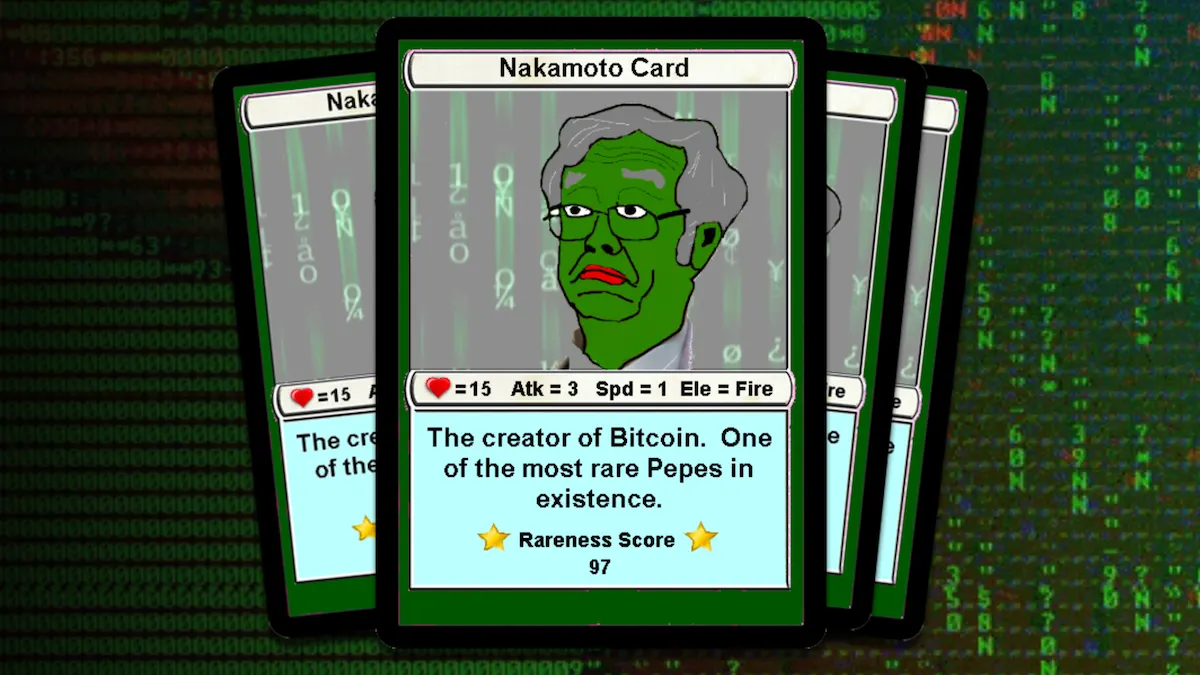Long before collections like CryptoPunks and CryptoKitties and the OpenSea marketplace helped popularize non-fungible tokens on Ethereum—even before the term "NFT" ever existed—an ecosystem for verifiably unique digital assets was already thriving on Bitcoin, circa 2014.
Counterparty is the platform that helped catalyze this innovation for the world and spark a multibillion-dollar industry. The platform uses Bitcoin’s technology to power more than just digital money, enabling verifiable ownership of digital assets like artwork and collectibles.
Here’s a look at how Counterparty works and how it differs from more recent NFT-centric platforms, plus a look at how these assets are being bridged to a larger audience via Ethereum.
What is Counterparty?
In traditional finance lexicon, a counterparty is the other person or party participating in a transaction. But in the Web3 world, Counterparty refers to a “metacoin-type protocol” founded in 2014 by Robert Dermody, Adam Krellenstein, and Evan Wagner.
With a native decentralized exchange (DEX) and token, Counterparty was built atop the open and decentralized Bitcoin network to let users mint, buy, and sell unique digital assets.
While this may be common today on platforms like Ethereum and Solana, at the time, Counterparty's launch marked a significant turning point in digital history. It helped people realize that Bitcoin's design can apply to any asset or transaction that requires a degree of verification—not just an alternative form of money, or a store of value.
Counterparty also set the stage for the global crypto art and collectibles movement, as seen with native projects like Spells of Genesis in 2015 and Rare Pepes in 2016—both considered seminal precursors to the modern NFT boom.
How does Counterparty work?
Similar to how Ethereum token standards define how certain assets work on its protocol, Counterparty provides the infrastructure that outlines how people can create unique tokens on the Bitcoin blockchain. These assets aren’t limited to digital collectibles or tokens, but anything with proven rarity—even physical items.
Counterparty is akin to a layer-2 solution for Bitcoin: a platform built on top of Bitcoin that inherits the security of the original blockchain, but provides additional functionality. In that sense, it’s similar to Stacks, another platform that’s built on top of Bitcoin to provide smart contract functionality to power NFTs and decentralized finance (DeFi) applications.
As Counterparty is Bitcoin-native and can embed and use data from the Bitcoin protocol when executing contracts, transacting on the platform looks just as it would when using BTC. Counterparty nodes simply interpret the data in these transactions based on specific rules. From there, the protocol creates its own ledger of related transactions that it has seen on the underlying Bitcoin network.
Another way to think about how transactions on Counterparty work is via the concept of nesting or Russian dolls, whereby the Bitcoin transaction would contain a smaller Counterparty transaction inside of it. Added complexities aside, the transactions on Counterparty are the same as Bitcoin, and therefore just as secure.
That said, a notable difference between Bitcoin and Counterparty is in the relationship between nodes. Unlike Bitcoin nodes, Counterparty nodes don't communicate with each other and don't offer a "peer-to-peer network." While they all share the same code and receive the same transaction data, the primary role of Counterparty nodes is to connect to the Bitcoin software.
Once connected, the nodes then download and decode data from each transaction all while benefiting from Bitcoin's security and computing power. In addition, as with gas on Ethereum, users still need to pay mining fees when transacting on Counterparty.
What else does Counterparty do?
Along with powering verifiably unique assets, Counterparty also supports a range of added functions. Some of these include:
- Multisignature addresses: “Multisig” refers to situations in which two or more individuals (via their private keys) must approve and sign off on transactions before they can execute. By providing multisig support, Counterparty offers more robust security and a comprehensive range of utility for its users, like helping remote teams work together. It also provides token issuers a safe way to store their assets, plus better control over distribution.
- Governance and voting: Users can also create and tap Counterparty tokens to vote for a desired outcome in a DAO or online community (e.g. DevParty). That said, stake voting with the native Counterparty currency, XCP, is still under development. It’s planned to allow for robust, decentralized governance of the Counterparty protocol.
- Counterparty DEX: Prior to Uniswap and SushiSwap, Counterparty launched one of the first successful decentralized exchanges, which functions as a native feature built into the protocol itself. As with any DEX, the protocol takes on the role of an escrow agent and clearing house, removing unnecessary costs, time, and third-party risks for users when making transactions. People can view open orders on the DEX through xchain.io (a related block explorer), and interact with it through supported wallets like Freewallet or Rare Pepe Wallet by placing buy and sell orders on assets they’d like to exchange.
How do dispensers work?
A common way to buy and sell assets on Counterparty is through automated dispensers. Similar to vending machines, anyone can set up a dispenser and specify an amount of the token or asset they want to sell through it, along with the price in BTC or Counterparty's own XCP token.
Buying assets from dispensers is not all that different from transferring or sending tokens between wallets. All a buyer needs to do is scan the dispenser QR barcode or manually copy the dispenser wallet address, and then send the amount of BTC or XCP they want to spend to buy one or more of the items on offer. Upon receipt, the dispenser will then distribute the asset to the buyer's wallet.
Another way to think about dispensers is as a basic smart contract with predefined rules that autonomously distribute and manage its assets. To help mitigate any risk or scams, an empty dispenser will display a warning sign alongside it, telling buyers not to send any BTC as the dispenser is closed.
What is XCP?
Buying assets on Counterparty and its dispensers can be done through the protocol’s native XCP token. Instead of the more traditional fundraising techniques for altcoin launches, like crowd sales or initial coin offerings (ICOs), Counterparty used the proof-of-burn (PoB) consensus protocol to issue XCP in January 2014.
To create a larger commitment to secure the network, a miner will burn a portion of coins in their possession to buy a virtual mining rig, which gives them the right and power to mine blocks on the Counterparty network. The more coins the miner burns, the larger his or her virtual mining "platform" will be.
The Counterparty team said that it settled on Proof of Burn to keep the distribution of tokens as fair and decentralized as possible, and avoid potential legal issues. To create XCP in the network, approximately 2,140 BTC—worth upwards of $2 million at the time—was destroyed or "burned" by sending them to a provably unspendable Bitcoin address with no known private key. In other words, they're lost forever.
The XCP token is also used in various ways in the Counterparty protocol, like helping users create new assets, trade, and make bets. XCP trades on exchanges like Dex-Trade and Zaif, paired with either BTC or the Japanese yen.

What are Counterparty’s biggest projects?
Since its release, many notable projects have been launched and supported on Counterparty. Some of these include:
- Spells of Genesis: In March 2015, EverdreamSoft released the first-ever blockchain trading card, FDCARD, on the Counterparty platform, which was later used in its strategic blockchain card game, Spells of Genesis. In the game, players can collect, trade, and combine assets called ORBs to build the strongest decks on the Bitcoin blockchain, test them against opponents, and explore the fantasy realm of Askian.
- Rare Pepes: In response to the demand for on-chain collectible assets, the first Rare Pepes—meme images based on Matt Furie’s original Pepe the Frog character—were minted in September 2016 and could be bought and sold through Bitcoin or XCP. A thriving ecosystem still exists on Counterparty, where collectors can buy original cards and the later fake rare, dank rare, and fake common cards.
- Bassmint: Created by a group of long-standing artists, musicians, and technologists in the Bitcoin community, Bassmint is a new cryptographic music directory and label on Counterparty designed to give more revenue and power back to creators. Through Counterparty, artists can mint their music and have it curated on Bassmint, and get paid in Bitcoin directly by fans.
- HODLpet: Known as the first "living creature" hosted on the Bitcoin blockchain, HODLpet is akin to an online Tamagotchi, collectively nurtured by a community of HODLers, or as a community-led choose-your-own-adventure story. Added features include NFT artwork drops by notable artists, plus a playable NFT card game.
- Phockheads: As one of the first-ever digital collectibles, Phockheads have been rescued from their inactive and somewhat forgotten home on Namecoin—an early blockchain platform forked from Bitcoin—to live again through Counterparty.
How is it connected to Ethereum?
However, these projects don't just live in isolation on Counterparty, thanks to the Ethereum Emblem Vault. Launched in September 2020, the Emblem Vault is a tokenized multi-asset wallet designed to support NFTs and fungible tokens alike on various blockchains.
Collectors can wrap their Bitcoin-based assets like Rare Pepes and Spells of Genesis Cards to bring them onto the Ethereum blockchain—as a native ERC-721 token—through the vault. That allows these projects to be traded via the leading NFT platform and through major marketplaces like OpenSea.
Doing so not only helps bring exposure to Counterparty projects, but also simplifies the trading experience for users that find Counterparty confusing or intimidating.
Which wallets are on Counterparty?
Counterparty offers a native wallet called Counterwallet. However, storing assets like Rare Pepes or XCP tokens can be done with a range of alternatives including:
- FreeWallet: a free, open-source wallet that supports Bitcoin and Counterparty. Through FreeWallet, users can send and receive BTC and tokens, create and issue tokens, sign and broadcast messages, and support multiple addresses. The app is available for both iOS and Android devices, and runs in web browsers as well.
- Rare Pepe Wallet: Created by noted developer Joe Looney, Rare Pepe Wallet is one of the best-known and most widely used Counterparty wallets for traders to collect and store Rare Pepe cards. People can also buy and search Rare Pepes through the wallet using BTC, PepeCash, or XCP.
- Freeport: As a Google Chrome extension, Freeport supports Bitcoin and Counterparty tokens. It also allows users to collect, trade, and create unique assets on Bitcoin.
The future of Counterparty
The NFT market exploded in popularity and awareness over the last couple years, driven by thriving platforms like Ethereum, Solana, and Flow. Counterparty doesn't have anywhere near the same level of hype or demand today, but its role in helping to pioneer the concept of unique, tokenized assets remains clear.
Even so, Counterparty has a dedicated community that has continued to work on the platform since its release. The developer scene welcomes builders and provides security-related bounties, and new contributors can run a node if they please.
As Counterparty is built on the back of Bitcoin’s security—which itself is enforced through the resource-intensive proof-of-work mining model—its native assets aren't at significant risk of being lost, nor do they rely on external storage servers like IPFS. The global network of miners and node operators helps secure the platform.
Just as Bitcoin serves as a cornerstone to the entire crypto economy, Counterparty has sustained its relevance through the collective array of memes, projects, and initiatives that have endured on the long-running protocol. It’s an important piece of the history of NFTs, now more accessible than ever thanks to the Ethereum Emblem Vault.






